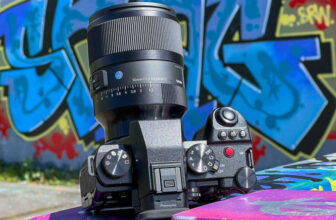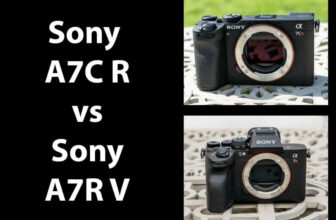
[adinserter block=”1″]
If you’re curious to learn about foreshortening in photography, this guide is for you.
When it comes to manipulating perspective, photographers have many techniques at their disposal.
Foreshortening is one such powerful technique that can help you breathe life into otherwise flat images.
It’s a way to add a hint of three-dimensionality to your two-dimensional photos.
In this guide, I’ll cover everything you need to know to use foreshortening in your photos like a pro.
So, let’s get started.
What is Foreshortening in Photography?
Foreshortening in photography is a technique that creates the illusion of depth in a photo.
It involves portraying the subject or object in a way that makes it appear shorter, compressed, or larger compared to its actual size.
With the foreshortening technique, you can achieve a sense of 3D in your photos using various angles and playing with the alignment of elements, poses, and composition.
To understand this effect better, snap a photo using a wide-angle lens of someone extending their arm out in front.
The resultant image will show the hand taking up a large space in the photo compared to the face.
In some cases, foreshortening can also be termed a forced perspective because it involves altering the perception of the size of the subjects.
One typical example of it is the photos where people appear to touch the top of the Eiffel Tower even though they’re comparatively smaller in size.
However, foreshortening is not just limited to these scenarios; it can occur due to many other factors.
Let’s discuss why foreshortening occurs in photography.
What Causes Foreshortening in Photography?
Understanding foreshortening can help you get better at storytelling in photography.
Foreshortening is a concept that originated in the world of drawing and painting, often seen in the work of master artists like Da Vinci.
It dramatically affects the perception of depth and spatial relationships in an image.
It’s the visual effect where an object appears compressed or enlarged when viewed from a particular angle, making it seem smaller or larger than it actually is, thus adding a sense of depth and realism to the photo.
Let’s understand the reasons that cause foreshortening in photos.
How Much Do You REALLY Know About Photography?! 🤔
Test your photography knowledge with this quick quiz!
See how much you really know about photography…

Camera Angle
The camera angle is one of the primary reasons for foreshortening in images. It’s all about the perspective from which the photo is taken.
For instance, shooting a subject from above can make certain body parts appear smaller, while shooting from below can have the opposite effect.
Imagine photographing a person lying down from their feet end – their legs will appear much larger than their head, creating a dramatic, unusual perspective that adds depth and drama to the picture.
Lens Choice
The focal length of the lens you’re working with is another significant cause of foreshortening.
Different focal lengths have different effects on how the subject is rendered in an image.
Wide-angle lenses, for example, tend to exaggerate foreshortening due to their larger field of view. They make objects closer to the lens appear more prominent and those farther away much smaller.
Telephoto lenses, on the other hand, tend to compress the scene, reducing the sense of depth and foreshortening.
Distance between elements in the frame
The arrangement of elements within a photograph significantly impacts foreshortening. Objects closer to the lens appear larger and more dominant, while those further away seem smaller and less significant.
This effect is not just limited to subjects in the frame; it also applies to the background elements.
A tree in the background can appear tiny compared to a flower in the foreground, creating a sense of depth in the photo.

Subject’s Pose
Along with the above factors, the subject’s pose can dramatically alter the effect of foreshortening.
Imagine clicking a photo of a model extending her arm towards the camera. The arm will appear disproportionately large compared to the rest of the body.
This distortion can be used creatively to emphasize certain aspects of the subject or to create a particular mood or narrative in the photograph.
How to Avoid Unintentional Foreshortening
Foreshortening, when used skillfully, can be a great technique for visual storytelling, enhancing the depth and drama in your images.
However, there are many occasions when you don’t desire the foreshortening effect. Sometimes, you might unintentionally create foreshortening that can distort the subjects in a photo, making them appear awkward and unflattering.
This is why it’s essential for photographers to understand how to avoid foreshortening in their work.
Knowing how to prevent it from happening accidentally makes a big difference to your photos.
Let’s see how you can do this.
Portrait Photography
In portrait photography, unintentional foreshortening can lead to awkward and unflattering results, such as making a nose or arm appear disproportionately large.

Below are some of the things to keep in mind to avoid foreshortening in your portrait photos.
- Use standard or long focal length: To avoid the distortion caused by foreshortening, I recommend using lenses with a standard (35mm or 50mm) or long (70mm and beyond) focal length.
- Avoid extending poses: You should be careful with how you’re posing your subjects to avoid foreshortened parts.
- Keep an eye on the background elements: Background elements can also contribute to unintended foreshortening.
- Shoot at eye level: Shooting portraits at eye level is often the safest way to avoid foreshortening issues.
Landscape Photography
Foreshortening in landscape photography can either enhance the sense of depth or distort the image in undesired ways.
You can avoid unintentional foreshortening in landscape photos by following the below practices.
- Be mindful of foreground elements: The size and placement of foreground elements can significantly affect the perception of depth.
- Avoid extreme angles: Shooting landscapes with extreme angles can distort the sense of space in the frame.
- Avoid juxtaposing elements in the frame: How you compose your shot is another important consideration when trying to avoid foreshortening in photography.
- Control depth of field: A deep depth of field helps maintain a consistent sense of scale throughout the image, avoiding the compression or stretching of space that can occur with a shallow depth of field.
Why Use Foreshortening in Photography?
Intentional use of foreshortening can be a powerful artistic tool, lending dynamism and depth to photographs.
It’s a technique that can help you elevate a simple composition to a visually appealing one.
Below are some reasons why you should use foreshortening in your photos.
Create an illusion of 3D
One of the primary uses of foreshortening is to create a sense of three-dimensionality in a two-dimensional medium.
By exaggerating the depth and scale of certain elements, photographers can make an image feel more lifelike and engaging.
For example, a road extending into the horizon can give the viewer a sense of walking into the photograph.

Emphasize the subject
One of the most common uses of foreshortening is to emphasize the subject or parts of it.
In portrait photography, for instance, a slightly elevated angle can make a person appear more dominant and imposing.
Similarly, in product photography, a close-up, angled shot can make the product appear more prominent and detailed.
Improve storytelling with layers
Storytelling is another important aspect of photography where foreshortening can be helpful.
It allows you to create layers in a composition, especially when you’re shooting on the street.
A photograph with multiple elements in the foreground, middle ground, and background can tell a more complex and engaging story.
For example, a street scene with some action happening in the foreground, cars in the middle ground, and more human elements in the background can create a rich narrative.
Create a sense of drama
Foreshortening can also introduce drama and tension to an image.
With exaggerated proportions and unusual angles, it can create a sense of movement and dynamism.
For example, a dancer with an extended leg shot from a low angle can appear more dramatic and powerful.
What is the Difference Between Foreshortening and Perspective?
Foreshortening and perspective are often confused, but they are distinct concepts in photography.
Perspective in photography refers to the representation of three-dimensional depth and space on a two-dimensional plane.
It’s about how objects appear to diminish in size as they recede into the distance. Primarily, there are three types of perspective in photography:
– One-point perspective: In this perspective, all lines converge at a single point on the horizon. It’s commonly seen in photographs of roads or railways stretching into the distance.
– Two-point perspective: This involves two sets of parallel lines converging at two different points, often used in architectural photography to give a sense of depth and structure to buildings.
– Three-point perspective: This perspective adds a third vanishing point, usually up or down, creating a sense of height or depth. It’s often used in skyscraper photography or in shots looking up or down from a significant height.

Foreshortening, on the other hand, is a technique that deals with the distortion of objects and subjects due to the angle of view.
It’s about how parts of a subject that are closer to the camera appear larger than parts that are farther away, regardless of their actual sizes.
For example, an outstretched hand towards the camera will appear larger than the head in the background, even though this is not the case in reality.
The main difference lies in the application and the outcome: perspective is about the overall spatial relationships in a photo, while foreshortening specifically focuses on the distortion of objects or body parts within the frame.
Foreshortening can be used along with various perspective techniques to add dynamism to a frame.
How to Make a Foreshortened Image
Creating a foreshortened image involves consideration of various factors such as camera settings, subject positioning, and composition.
Let’s explore specific techniques in different types of photography.
Portrait Photography Foreshortening

In portrait photography, foreshortening is a technique that can add depth, intrigue, and artistic flair to your images.
By manipulating the perceived size and shape of your subject with the camera angle and the subject’s pose, you can create compelling portraits that stand out.
Let’s explore various ways to achieve foreshortening in portrait photography, focusing on specific poses that can enhance this effect.
Utilize Camera Angles
Shooting from above or below the subject can drastically change how their body appears.
A lower angle can make the legs or feet seem more prominent, while a higher angle can emphasize the face or upper body.
Choose the Right Lens
Wide-angle lenses exaggerate foreshortening, making them ideal for creative and dramatic effects.
Control the Distance
The closer the subject’s body part is to the camera, the larger it will appear. Encourage your subject to extend arms or legs toward the lens to enhance this effect.
Play with Perspective
Arrange the subject against a background that enhances the foreshortening effect.
For example, a long hallway or a row of trees can add depth and perspective to your composition.

Portrait Photography Poses for Foreshortening
1. Extending a Limb Out
Extending a limb towards the camera can dramatically alter the perceived proportions of the limb, making it appear larger and longer.
This technique is particularly effective in creating a sense of movement or drawing attention to a specific attribute of the subject. For example, a dancer extending a leg towards the camera in a mid-dance pose can emphasize the movement.
2. Folding Hands in Front
Having the subject fold their hands in front and bringing them closer to the camera can make the hands appear larger than they are, creating an intimate and engaging effect.
This pose can be used to convey a sense of thoughtfulness or introspection, making the viewer focus on the subject’s expression and hand gesture.
3. Kicking Pose
A dynamic and energetic pose, like kicking towards the camera, can create an impactful visual statement. This pose can make the leg appear elongated, adding a sense of motion and vitality to the portrait.
It works well in sports or action-themed portraits where you want to capture and emphasize the subject’s physical abilities.
4. Lying with Hands Cupping the Face
This pose, where the subject lies down and cups their face with their hands, brings the hands into the foreground, making them a prominent element of the composition.
It’s a great way to create tender and intimate photos, drawing the viewer’s attention to the subject’s facial features framed by their hands.
5. Looking Down Pose
When the subject looks down towards the camera that’s positioned at a low angle, it makes the head and eyes appear larger, creating a sense of closeness and intimacy.
This pose is particularly effective in close-up portraits where you want to highlight the subject’s facial expressions and emotions.
6. Looking Up Pose
Having the subject look up towards the camera can elongate the neck and alter the facial proportions, adding a sense of aspiration or contemplation.
This pose can be used to convey a feeling of hopefulness or reflection, drawing the viewer’s gaze upward along with the subject’s.
Each of these poses offers a unique way to use foreshortening in portrait photography.
By understanding how the camera angle and the subject’s position affect the viewer’s perception, you can create portraits that are not only visually striking but also rich in meaning and emotion.
Experimenting with these poses will allow you to discover new creative possibilities and develop a more nuanced approach to portrait photography.
Landscape Photography Foreshortening
Foreshortening in landscape photography is a technique that can dramatically change the viewer’s perception of space and depth in a scene.

It’s about creatively manipulating the elements in your frame to produce a more dynamic, engaging composition.
Unlike portrait photography, where the focus is usually on a single subject, landscape photography presents an opportunity to play with vast spaces and multiple elements.
Below are various ways to create foreshortening in landscape photography.
Utilize Foreground Elements
When shooting landscapes, including objects in the foreground can create an immediate sense of depth.
For instance, placing rocks or foliage in the lower part of the frame can make them appear larger compared to the mountains or structures in the background.
This not only adds depth but also guides the viewer’s eye through the image.
Play with Perspective and Scale
You can try juxtaposing elements of varying sizes to enhance the sense of scale and depth.
A tree in the foreground next to a distant mountain can dramatically emphasize the size of the mountain, creating a compelling depth in the photograph.
Choose the Right Vantage Point
The viewpoint from which you capture your landscape can significantly impact the perception of depth.
A higher vantage point can provide a sweeping view, compressing the scene and giving a grand sense of scale.
Conversely, a lower viewpoint can exaggerate the height and depth of elements like cliffs or buildings.
Use Leading Lines
Use natural or man-made lines in the landscape to lead the viewer’s eye into the frame.
Roads, rivers, or even patterns in the sand can draw the viewer into the scene, creating a sense of depth and distance.
Experiment with Lens Choice
Wide-angle lenses are great for exaggerating depth and perspective in landscape photography.
They can make foreground elements appear larger and more pronounced while still capturing the vastness of the background.
However, be mindful of distortion at the edges of the frame.
Layer Different Elements
Create layers in your composition by positioning elements at varying distances from the camera.
This could be a combination of a detailed foreground, a mid-ground with interesting textures or features, and a dramatic background, like a mountain range or a dramatic sky.
Control Depth of Field
While a deep depth of field is often preferred in landscape photography to keep everything in focus, playing with a shallower depth of field can emphasize certain parts of your scene, creating a unique foreshortened effect.

Work with Light and Shadows
The interplay of light and shadows can greatly enhance the sense of depth in a landscape.
Early morning or late afternoon light casts long shadows that can elongate forms and exaggerate perspectives, adding to the foreshortening effect.
By incorporating these techniques, you can create landscape images that not only capture the beauty of a scene but also convey a powerful sense of depth and scale.
Foreshortening in landscape photography, when done thoughtfully, can transform a flat image into a dynamic visual experience that invites the viewer to explore every part of the scene.
Product Photography Foreshortening
Foreshortening in product photography can add an impactful dimension to the images, making them more engaging and visually appealing.
Let’s explore various ways to employ foreshortening in product photography.
Angle the Product for Emphasis
Positioning the product at an angle where part of it is closer to the camera can dramatically alter its perceived size and shape.
For example, angling a watch so that its face is closer to the camera can make the watch’s dial appear more prominent, drawing attention to its details.
Use a Wide-Angle Lens for Exaggeration
Similar to portrait and landscape photography, wide-angle lenses are great for exaggerating certain features in product photography.
This technique can be used to make a part of the product appear larger than life, which can be effective in highlighting specific features or designs.
Explore Creative Perspective
Manipulating the perspective can change the way viewers perceive the size and shape of the product.
Shooting from a lower or higher angle can make the product appear more imposing or delicate, respectively.
For instance, shooting a bottle of perfume from a lower angle can give it a taller, more elegant look.
Experiment with Close-up and Macro Shots
Close-up and macro shots can create a sense of foreshortening by bringing the viewer extremely close to part of the product.
This technique can be used to highlight textures, materials, or intricate details that might be lost in a wider shot.
Play with Shadows and Lighting
Using lighting and shadows strategically can enhance the foreshortening effect in photos.
By creating strong contrasts and highlights, you can give the product a three-dimensional feel, making it pop out of the image.
Combine with Other Elements
Placing the product in context with other elements can also create a foreshortened effect.
For example, placing a pair of sunglasses on a beach towel shot from closeup can give viewers a sense of depth and perspective, making the sunglasses appear more prominent.
Common Mistakes to Avoid When Using Foreshortening in Photography
Achieving a successful, foreshortened image requires careful consideration of various elements.
Here are some common mistakes to avoid for optimal results with foreshortening in photography.
Ignoring the overlap of subjects
A common mistake in using foreshortening is not paying attention to how subjects overlap in the frame.
Overlapping elements can create a sense of depth, but when done carelessly, it leads to a cluttered and confusing composition.
For example, in a group portrait, if one person’s arm appears disproportionately large due to foreshortening and overlaps with another person’s face, it can distract from the overall harmony of the image.
Maintaining a clear distinction between subjects is crucial for a clean, well-composed shot.
Using a very shallow depth of field
While a shallow depth of field is often used to isolate the subject and create a pleasing background blur, it can be detrimental in foreshortened images.
For example, if you are photographing a person with an extended hand using a wide aperture, the hand might be in sharp focus while the rest of the body blurs out, leading to a confusing composition.
In such cases, using a smaller aperture to increase the depth of field ensures that all parts of the subject are in focus to effectively use the foreshortening effect.
Using the wrong focal length
The choice of focal length you’re using dramatically impacts the extent of foreshortening.
Wide-angle lenses exaggerate foreshortening, while a telephoto lens will compress it.
A common mistake is using an extremely wide-angle lens for portraits, which can make features like noses or hands look unnaturally large when they are closer to the lens.
Conversely, using a telephoto lens for a shot where you intend to emphasize foreshortening can diminish its effect.
Choosing the right focal length based on your creative intent is the most important factor in foreshortening.

Ignoring foreground in landscape photos
In landscape photography, ignoring the foreground can lead to a flat image lacking depth.
For example, a mountain range shot with no elements in the foreground can appear less imposing and distant.
Including elements like rocks, plants, or even a person in the foreground can create a sense of scale and depth, making the mountains appear more majestic and the image more dynamic.
Using awkward angles in portrait photos
Choosing the right angle is essential in portrait photography to avoid unflattering foreshortening.
An upward angle can make the chin and nose appear larger, while a downward angle can enlarge the forehead.
Striking the right balance and choosing angles that flatter your subject is important.
For example, shooting slightly above eye level can often result in a more balanced and natural portrayal of the face.
Foreshortening Examples
Let’s take a look at some of the common examples of foreshortening in photography.
The points below highlight the best ways to use the foreshortening technique in your images.
Worm’s-eye view portrait
An ant-eye or worm’s-eye view, where the camera is positioned low and angled upwards, can create a dynamic and imposing portrait.
This angle can make the legs appear longer and the body taller, giving the subject a commanding presence.
This technique works well for full-body shots, where the aim is to impart a sense of strength and dominance to the subject.
Extending a part of the body to look larger
A classic example of foreshortening is having the subject extend a body part, like a hand or foot, towards the camera.
This can make the body part appear significantly larger than it is, creating an interesting visual effect.
For example, a dancer extending a leg towards the camera in a leap can emphasize the motion and energy of the dance.
Low-angle landscape shot
Shooting from a low angle in landscape photography can make foreground elements appear larger and more prominent, adding depth and scale to the scene.
For example, shooting a field of flowers from a low angle can make the flowers in the foreground appear larger, leading the viewer’s eye into the scene and toward the horizon.
Looking-down portrait
A picture taken from a high angle looking down can make the subject’s head and eyes appear larger, often creating a sense of intimacy and vulnerability.
This angle is particularly effective for close-up portraits, where the emphasis is on the subject’s facial expressions.
High-angle architecture shot
Capturing architectural structures from a high angle can create dramatic foreshortening effects.
Take the HARD Photography Quiz! 🤯
Now it’s time to really test your photography knowledge!
(99% of people can’t get all the questions right…)

For instance, shooting a skyscraper from its base looking upwards can make the building appear to stretch dramatically towards the sky, emphasizing its height and grandeur.
Foreshortening Photography Ideas
Here are some creative ideas for experimenting with foreshortening in your photography.
Shoot a tall building looking up
Position yourself at the base of a skyscraper and shoot straight up. This angle will create a dramatic perspective, making the building seem taller and more imposing.
The lines of the building will converge towards the top, drawing the viewer’s eye upwards and emphasizing the building’s height.
Force perspective by aligning different elements
Play with the alignment of different-sized elements to create a forced perspective. For instance, you can photograph a person holding out their hand to ‘touch’ the top of a distant building.

This creates an illusion where the building appears small enough to be touched, adding a whimsical and creative element to the image.
Capture subjects in layers
You can use multiple layers in your composition to enhance depth. For example, in a street scene, you can combine and freeze action in the foreground and mid-ground against an interesting background.
This layering, combined with foreshortening, adds complexity and richness to the composition.
Take an eye-level portrait of your pet with a wide focal length
Get down to your pet’s level and use a wide-angle lens to capture a striking pet portrait.
This can make features like their nose or paws appear more prominent, adding a cute and playful effect to the image.
Final Words
In this article, we’ve explored the various aspects of foreshortening in photography, its applications, and common mistakes.
Foreshortening is not just a technique but an artistic tool that, when used skillfully, can greatly enhance the impact and expression of a photo.
If you’ve got any questions or feedback, please let me know in the comments.
FAQ
Why is it important to learn about foreshortening?
Understanding foreshortening is essential for photographers as it is a critical element in creating depth and three-dimensionality in images.
It allows for more dynamic compositions and can add a dramatic effect to photographs, enhancing visual storytelling.
Who is most famous for using the technique of foreshortening?
Some of the top street and travel photographers use foreshortening in their work.
In the painting world, Renaissance artists are renowned for their use of foreshortening, which they employed to create depth and realism in their work.
What is the foreshortening of the lens?
Foreshortening of the lens refers to the distortion that occurs when using certain lenses, particularly wide-angle lenses, where objects closer to the lens appear much larger compared to those farther away.
This effect can be used creatively to emphasize certain parts of a scene or subject.
Highly Recommended

Check out these 8 essential tools to help you succeed as a professional photographer.
Includes limited-time discounts.
Learn more here
[adinserter block=”1″]
Credit : Source Post






